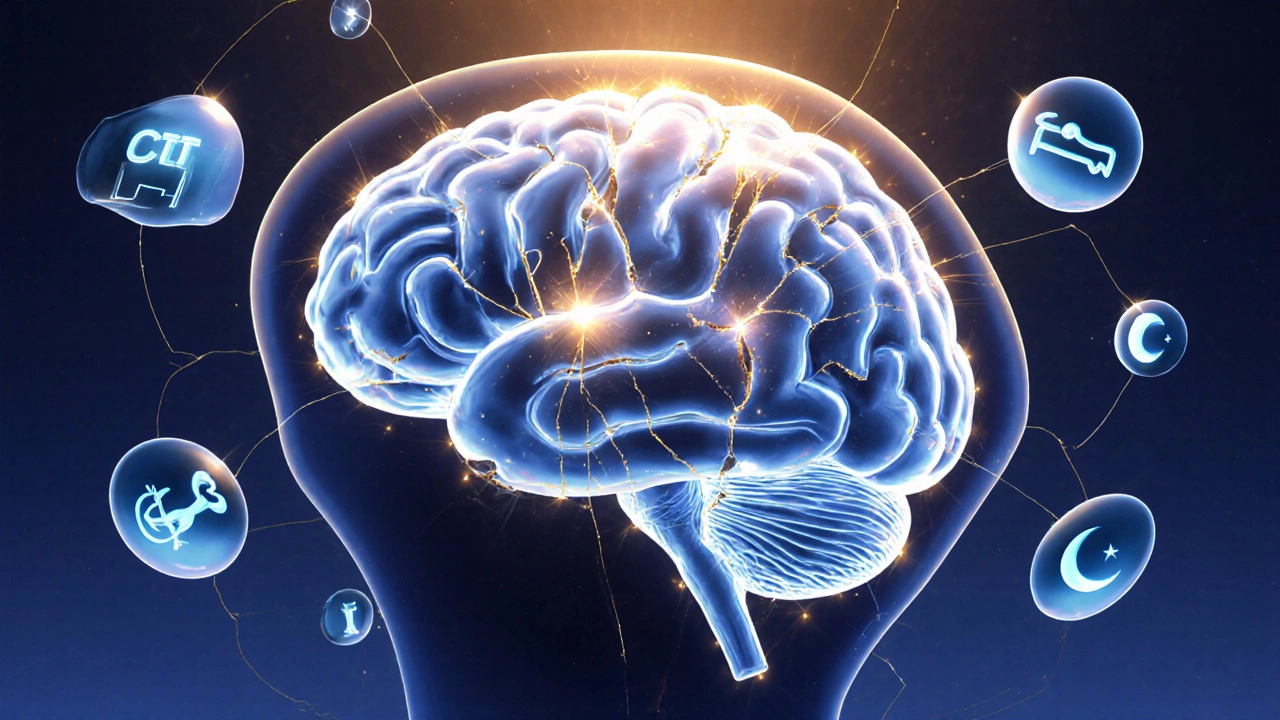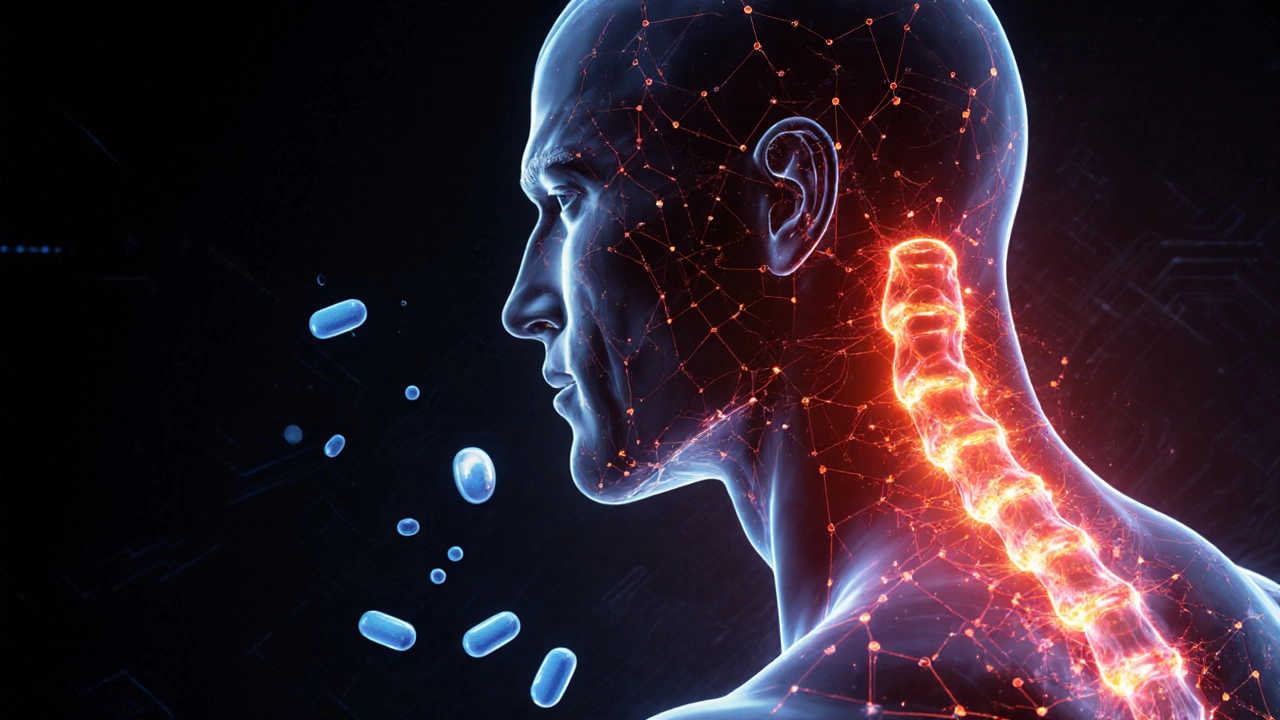You took your painkillers like clockwork. You waited. You hoped. But the ache? It’s still there. Maybe worse. You’re not imagining it. And you’re not alone. Millions of people with chronic pain take medication every day-only to feel like they’re fighting a battle they can’t win. Why do painkillers sometimes just… not work?
Pain isn’t just a signal-it’s a system
Think of pain like an alarm system. When you stub your toe, nerves send a message to your brain: danger! Painkillers like ibuprofen or paracetamol usually quiet that alarm by reducing inflammation or blocking pain signals. But in chronic pain, the alarm doesn’t turn off. It gets stuck. The system rewires itself. Nerves start firing on their own. Your brain starts interpreting even light touches as threats. This isn’t ‘all in your head.’ It’s neuropathic pain-a real, measurable change in how your nervous system processes signals.
Most over-the-counter painkillers were designed for short-term, injury-related pain. They don’t fix broken wiring. If your pain comes from a pinched nerve, diabetic neuropathy, or fibromyalgia, those pills are like trying to silence a smoke alarm by covering it with a towel. The fire’s still burning.
Not all pain is the same
There are three main types of pain, and each responds differently to medication:
- Nociceptive pain: Caused by tissue damage-like a sprained ankle or arthritis. Usually responds well to NSAIDs or opioids.
- Neuropathic pain: Caused by nerve damage. Feels like burning, tingling, or electric shocks. Often doesn’t respond to standard painkillers.
- Nociplastic pain: No clear tissue or nerve damage, but the pain system is hypersensitive. Think fibromyalgia or chronic back pain with no structural cause. These respond poorly to traditional meds.
If your pain has lasted more than three months and doesn’t improve with standard painkillers, it’s likely not nociceptive. That means your treatment needs to change-not just your dose.
Medication resistance isn’t failure
Some people assume that if painkillers stop working, they’ve built up a tolerance. That’s partly true with opioids-but not with most other pain meds. With drugs like ibuprofen or paracetamol, tolerance is rare. What’s happening instead is called medication mismatch. You’re using the wrong tool for the job.
Take gabapentin or pregabalin. These aren’t painkillers in the traditional sense. They calm overactive nerves. For someone with sciatica or post-shingles pain, they can cut discomfort by 50% or more. But if you give them to someone with a broken hip? They won’t help much. The same goes for antidepressants like amitriptyline. They’re not treating depression here-they’re modulating pain signals in the spinal cord.
It’s not that the drugs are weak. It’s that they weren’t meant for your kind of pain.

Why dose increases don’t fix it
You might be tempted to take more. Maybe you doubled your dose. Maybe you switched to a stronger prescription. But pushing higher doses of NSAIDs or opioids comes with serious risks: stomach ulcers, liver damage, addiction, or even overdose.
A 2023 study in the British Journal of Anaesthesia followed 1,200 chronic pain patients on long-term opioids. Nearly 60% reported no meaningful pain reduction after six months-yet many kept increasing their dose. The result? More side effects, no better relief.
Increasing the dose of the wrong medication is like turning up the volume on a radio playing static. The noise gets louder, but you still can’t hear the song.
What actually works when painkillers fail
Chronic pain management isn’t about one magic pill. It’s about stacking strategies. Here’s what works when medications fall short:
- Physical therapy: Especially for back, neck, or joint pain. Movement retrains your nervous system. A 2024 meta-analysis found that structured physiotherapy reduced chronic pain by 40-60% in patients who didn’t respond to drugs.
- Cognitive behavioural therapy (CBT): Helps your brain unlearn pain patterns. Studies show CBT is as effective as opioids for long-term pain reduction-with zero side effects.
- Low-dose naltrexone (LDN): An off-label option gaining traction. It resets immune and nervous system activity. Many patients with fibromyalgia or autoimmune-related pain report dramatic improvement.
- Nerve blocks or neuromodulation: For localized nerve pain, injections or spinal cord stimulators can interrupt faulty signals.
- Exercise and sleep: Two of the most powerful, underused tools. Poor sleep raises pain sensitivity by up to 30%. Regular movement lowers inflammatory markers.
One patient I worked with in Dublin-let’s call her Sarah-had been on oxycodone for five years after a car accident. Her pain didn’t improve. She felt foggy, constipated, and hopeless. After switching to a combination of physiotherapy, CBT, and LDN, her pain dropped from 8/10 to 3/10. She stopped opioids. She started walking again.

When to ask for help
If you’ve been taking painkillers for more than six weeks and still feel pain, it’s time to ask for a pain specialist. Your GP might not have the training to manage complex chronic pain. A pain clinic can offer:
- Pain type diagnosis using nerve tests or questionnaires
- Personalized medication plans (not just higher doses)
- Access to non-drug therapies like TENS, acupuncture, or biofeedback
- Coordination with psychologists, physiotherapists, and occupational therapists
Don’t wait until you’re desperate. Chronic pain worsens over time if left unmanaged. The longer your nervous system stays in overdrive, the harder it is to reset.
The myth of the ‘strongest’ painkiller
There’s no such thing as the ‘strongest’ painkiller for chronic pain. Opioids are powerful-but they’re terrible for long-term use. They don’t fix the problem. They just mask it. And over time, they can make pain worse through a phenomenon called opioid-induced hyperalgesia. That’s when the body becomes more sensitive to pain because of the drug itself.
What you need isn’t more strength. It’s better targeting.
What to do next
If painkillers aren’t working, here’s your action plan:
- Stop blaming yourself. This isn’t weakness. It’s biology.
- Track your pain: Note when it flares, what makes it better or worse, and how you feel emotionally. This helps specialists identify patterns.
- Ask your doctor: ‘Could this be neuropathic or nociplastic pain?’
- Request a referral to a pain management clinic. Don’t take ‘no’ for an answer.
- Start small: Add 10 minutes of walking or gentle stretching daily. Improve sleep hygiene. These aren’t quick fixes-but they’re proven to reduce pain sensitivity over time.
Pain doesn’t have to be your permanent roommate. But fixing it requires more than a pill bottle. It requires understanding. It requires patience. And it requires the right team.
Why do my painkillers stop working after a while?
They don’t usually lose effectiveness because of tolerance-especially with NSAIDs or paracetamol. More often, your pain has changed type. If it’s moved from injury-related to nerve-based or hypersensitive pain, the same medication won’t work. You need a different approach, not a higher dose.
Can I become addicted to painkillers if I take them long-term?
With opioids, yes-especially if used daily for more than a few weeks. With ibuprofen, paracetamol, or even gabapentin, addiction is rare. But dependence can happen. Physical side effects like constipation, drowsiness, or liver stress are more common than addiction. Always discuss long-term use with your doctor.
Is it normal to feel more pain when I stop taking painkillers?
If you’ve been on opioids long-term, you might experience withdrawal symptoms or rebound pain. That’s not your original pain returning-it’s your nervous system reacting to the sudden absence of the drug. This is why stopping opioids should be done slowly and under medical supervision. For non-opioid painkillers, stopping usually doesn’t cause increased pain.
What’s the difference between neuropathic and nociceptive pain?
Nociceptive pain comes from damaged tissue-like a cut, sprain, or arthritic joint. It usually feels sharp, aching, or throbbing. Neuropathic pain comes from damaged or overactive nerves. It often feels like burning, shooting, tingling, or electric shocks. The treatment for each is very different.
Can exercise really help chronic pain?
Yes-especially if it’s gentle and consistent. Movement reduces inflammation, improves circulation, and helps your brain relearn that movement isn’t dangerous. Studies show even walking 20 minutes a day can reduce chronic pain intensity by 30-50% over 8-12 weeks. Start slow. Listen to your body. Pain during exercise doesn’t always mean damage.
Should I see a specialist if my GP says my pain is ‘just chronic’?
Absolutely. ‘Chronic pain’ is a description, not a diagnosis. There are dozens of underlying causes. A pain specialist can run nerve tests, review your medication history, and identify whether your pain is nerve-related, autoimmune, or central sensitization. Most GPs aren’t trained to manage complex chronic pain. A specialist can open doors to treatments your GP might not know about.




